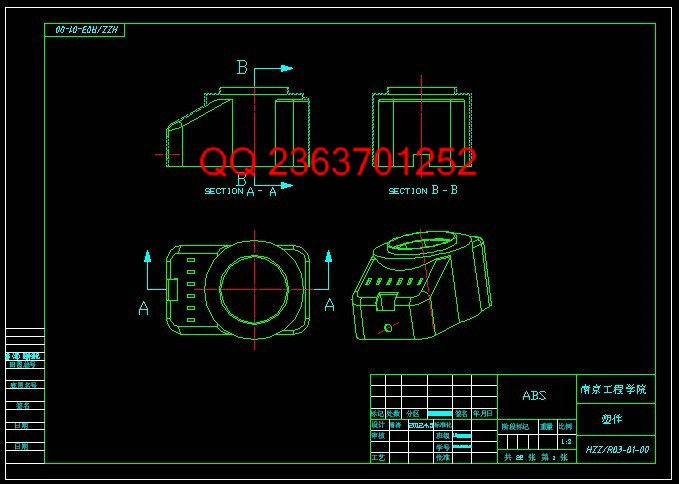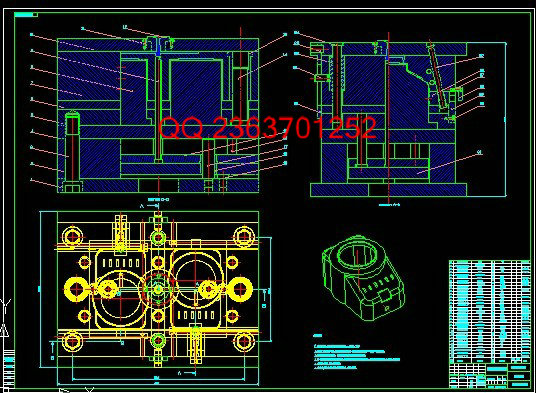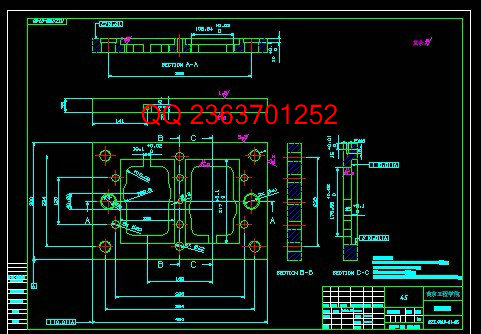|
设计描述:
文档包括:
WORD版设计说明书1份,共61页,约22000字
任务书一份
PPT答辩一份
开题报告一份
外文翻译一份
CAD版本图纸,共22张
中文摘要
模具是工业生产的重要工艺装备,在现代工业生产中,60%~90%的工业产品需要使用模具,模具工业已成为工业发展的基础,许多新产品的研制与开发在很大程度上依赖于模具的生产。因此,研究和发展模具技术,提高模具水平,对促进国民经济的发展有着特别重要的意义。
本文根据相机外壳的结构特点及技术要求,通过一系列的注射模设计流程,设计了带侧抽芯的塑料模具,并利用UG与Moldflow软件对其进行了分析。对塑件进行了工艺分析,确定了塑件的尺寸及结构。在模具的设计中详细介绍了斜导柱、型芯、型腔等零部件的设计与制造,以及注射机和模架的选择。
关键词 相机外壳 注射模 侧抽芯 Moldflow
毕业设计说明书(论文)外文摘要
Title Injection Mold Design of Camera Cover Based on UG
Abstract
Mold is important process equipment of industrial production, in the modern industrial production, 60%~90% of industrial products need to use mold, the mold industry has become the foundation of industrial development, research and development of many new products are largely dependent on mold. Therefore, the research and the development of mold technology are significant to promote the development of the national economy.
This paper completes a series of injection mold design process and designs the plastic mold with side core pulling based on the structural features and technical requirements of camera cover. The software of UG and Moldflow are used to analyze the mold. Plastic parts are analyzed in the design process, at the same time, the size and structure of the plastic parts are determined. The design and manufacturing of slanted guide pillar, mould core, cavity and other parts are introduced in detail, as well as the injection molding machine is chosen correctly.
Keywords camera cover injection mold side core pulling Moldflow
目 录
前言 1
第一章 塑料模的功能 2
第二章 塑件成型工艺分析 3
2.1 拟定制品成型工艺 3
2.2 热塑性塑料ABS的注射成型工艺 3
2.2.1 ABS的注射成型工艺参数 3
2.2.2 ABS材料综合性能分析 4
第三章 拟定模具结构形式 6
3.1 分型面位置的确定 6
3.2 确定型腔数量及排列方式 7
第四章 注塑机型号的确定 8
4.1 注射量的计算 8
4.2 塑件和流道凝料在分型面上的投影及所需锁模力的计算 8
4.3 选择注射机 9
4.4 有关参数的校核 10
第五章 浇注系统形式和浇口的设计 12
5.1 浇注系统的设计 12
5.1.1 主流道设计 12
5.1.2 分流道的设计 14
5.2 浇口的设计 16
5.2.1浇口设计的技术要求 17
5.2.2浇口尺寸的确定 19
5.3 冷料穴的设计 20
5.4 拉料杆的设计 22
5.5 浇注系统的平衡 22
5.5.1 分流道平衡 22
5.5.2 浇口平衡 23
第六章 模架的确定和标准件的选用 24
6.1 模具各个板料尺寸的确定 25
6.1.1 定模座板 25
6.1.2 定模板(型腔板) 25
6.1.3 动模板 25
6.1.4 推件板 25
6.1.5 动模垫板 25
6.1.6 垫块 26
6.1.7 动模座板 26
第七章 合模导向机构的设计 27
7.1 导向结构的总体设计 27
7.1.1 导柱的设计 27
7.1.2 导套的设计 28
第八章 脱模推出机构的设计 30
8.1 脱模推出机构的设计原则 30
8.2 制品推出的基本方式 30
8.3 塑件的推出机构 30
8.4推件板推出机构设计要点 31
8.5 复位机构设计 33
第九章 抽芯机构设计 34
9.1 侧向分型与抽芯机构的分类 34
9.2 斜导柱抽芯机构的设计 34
9.2.1 斜导柱的倾斜角的确定 35
9.2.2 侧向抽心力的计算 35
9.2.3 斜导柱的弯曲力的计算 36
9.2.4 斜导柱直径的计算 36
9.2.5 斜导柱的长度计算 38
9.2.6 锁紧楔的设计 38
第十章 成型零部件的设计 39
10.1 成型零件的结构设计 39
10.1.1 凹模的结构设计 39
10.1.2 凸模的结构设计 40
10.2 成型零件工作尺寸的计算 41
10.2.1 影响工作尺寸的因素 41
10.2.2 成型零件工作尺寸的计算 41
10.3 成型零件强度计算 44
10.3.1 型腔侧壁厚度计算 44
第十一章 排气系统的设计 47
11.1 排气设计的要点 47
11.2 排气系统的几种方式 47
12.2.1 冷却水道开设的技术要点 48
12.2.2 冷却回路的布置: 48
第十二章 温度调节系统设计 49
12.1 加热系统设计 49
12.2 冷却系统设计 49
12.3 型芯的冷却 50
12.4 冷却系统的有关计算: 50
结束语 52
致 谢 53
参考文献 54
| 







